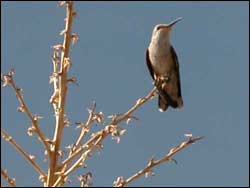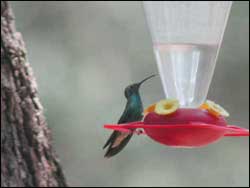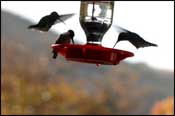Hummingbirds
Tiniest of all the birds, the hummingbird is an amazing creature – probably the most unusual member of the bird family. Of all of the billions of hummingbirds that may have lived throughout the ages, no fossils have been found that would give clues to this bird's ancestry. They live only in the western hemisphere, and most of them are found in Central and South America, although they range from Alaska to the tip of Argentina. Although there are more than 300 species, only 18 are found regularly in the United States. Of these, 9 are common to Texas, and an additional 6 have made accidental appearances in the state.
Perhaps the most amazing thing about the tiny hummingbird is its energy level. From a standing start, it can rev up its speed to an unbelievable sixty miles per hour in a distance of three feet. It has the highest energy output per unit of body weight of any animal in the world. According to the Institute of Aeronautical Sciences, a hovering hummingbird consumes about 726 Btu of energy per pound per hour. This is very close to the 750 Btu consumed by a helicopter in flight.

Light and motion are required for the hummer's throat feathers to flash their vivid colors. The male black-chinned hummingbird's throat flashes a beautiful royal purple stripe.
Comparisons with human energy use are even more astounding. When hovering, the hummingbird's energy output is ten times that of a man running at nine miles per hour (the highest output of human energy known, and a speed that cannot be maintained for more than half an hour). The average man burns about 3,500 calories a day. If the daily output of a hummingbird were calculated for a 170-pound man, he would need to burn about 155,000 calories. Translated into food intake, to keep up with the energy a hummingbird burns each day, a human would have to eat 285 pounds of hamburger or 370 pounds of potatoes.
Keeping its miniature power plant fueled requires the hummingbird to feed every ten to fifteen minutes. However, since the bird cannot maintain such a demanding feeding program on a twenty-four-hour basis, it deals with the problem by going into a hibernationlike state at night. While in this condition, known as torpor, it is unable to move. Its body temperature drops to that of the surrounding air and its energy rate drops to one-twentieth of the daytime level. Even at this lower level, the energy used by the bird is about the same as that of a human exercising vigorously. Although most animals cannot be awakened from torpor quickly, the hummingbird's arousal is almost instantaneous.
Sugar is the main energy source for the hummingbird, usually in the form of nectar from tubular-shaped flowers. The bird also gets protein by eating small spiders, which are plucked from their webs, and insects, which are caught on the wing. The birds often are seen feeding amidst swarms of small insects or catching those attracted to oozing tree sap. It is estimated that about 25 percent of their diet is insects.
The hummingbird's tongue and bill are perfectly adapted for obtaining its food. The bill is long and sharp and can plunge deep into the flowers or slash them open to get at the nectar. The tongue, which is extremely long, can be extended beyond the bill. (Hummingbirds and woodpeckers are the only birds that can do this.) The front part of the tongue is split, and the outer edges curl for part of the length to form two parallel tubes that are used like straws to suck nectar from the flowers. The outer edges are frayed like a brush to make it easier for the bird to gather insects.

When a Mexican green violet-ear hummingbird paid a rare visit across the border to Texas, birders came from all over the country to watch it sip from a backyard feeder in Austin and to record the event on film.
Because of its high energy output and its dependence on plant nectar, the hummingbird's northward migration is timed closely to the blooming of certain flowers that will meet its feeding needs. Pollen, which may be transferred to the bird's head as it dips deep into the blossom, is spread to other flowers as the bird continues its feeding. This makes the hummer one of the important pollinators of tubular flowers.
Its flight is another characteristic that makes the hummingbird unique, and it is the reason the bird needs so much energy. It cannot soar the way other birds do, or just flap its wings a few times and glide. Its wings must be in constant motion to keep it in the air. A few other species, such as the ospreys, kingfishers, and sunbirds, can hover somewhat in flight, but only the hummingbirds can hold their bodies still in mid-air with their fast-beating wings. No other bird can match the flying skill of the hummingbird, which not only hovers, but also flies up, down, and backwards.
Since its wings must be used for long periods of time without rest, and since these wings move extremely fast, the hummingbird's breast muscles are huge in proportion to its size. They weigh about a third of its total weight, and the muscles used to draw the wings upward are almost as powerful as those that drive the wings down. In relation to its body size, the hummer also has the largest heart in the bird world. A large, strong heart is needed to circulate the oxygen and nutrients needed for this bird's high-energy lifestyle.
The hummingbird's narrow wings have no more than a four-inch span, and those of some species are even smaller. The "hand" portion of its wing is the longest part; the "arm" portion is quite short. The joints at the "wrist" and "elbow" are fused to give the wings a strong frame, and they are attached to the shoulders in such a way as to allow movement in any direction. The wings beat in a figure-eight pattern at such tremendous speeds that they almost vanish in a blur. This wing movement produces the humming sound that gives the birds their name. The power of flight in most birds is in the downstroke. The upstroke is merely a recovery motion to prepare the bird for another powerful downstroke. However, in the all-directional flight of the hummingbird both strokes are powerful. Forward flight is generated on the downstroke. When the tiny bird reaches speeds of up to sixty miles per hour, its wings may be beating as fast as eighty times a second, depending on the species. Some may beat at an even faster rate.

A backyard feeder will allow you to attract hummingbirds, but proper care and maintenance of the feeder is a necessity.
To hover, the hummingbird tilts its body and wings into a more vertical position. This causes the main flight feathers to push air downward instead of backward. The downstroke and up-stroke provide lift but not forward movement. On the downstroke, the wings are tilted so that they force air downwards and the bird upwards. At the end of the downstroke, the wings twist 90 degrees. This forces air downward on the upstroke as well. To fly backward the wings are tilted slightly so that air also is forced forward, which drives the hummingbird back. Hummingbirds do not take off by leaping into the air as other birds do. Instead, they lift off with rapid wingbeats. Specialized filming has shown that a hummingbird taking off from a thin twig actually pulls the twig up a little before letting go as it rises. Its short, thin legs and tiny feet are not used for walking or hopping. The bird depends almost entirely on its wings to move from place to place, using its feet and legs only for perching or sidling along a tree limb.
The courtship flight of the male hummingbird is a stunning display of aerial acrobatics that varies according to the species. No other bird can equal his speed and agility. Like a stunt flyer, he may start his performance with a power dive in a U-shaped curve before the watching female. Once he has her attention, he really puts on a show. For variation, he may dart at the female like a bullet, brake quickly, shoot straight up for fifty feet, and then plummet back, catching himself in mid-air just beside or in front of her. Every movement reflects the dazzling colors of his iridescent neck feathers and attempts to convince her that he would make a fine mate.
These beautiful iridescent colors are a trademark of the hummer, especially the male's flashing, jewellike throat patches, known as gorgets. These colors often are used to name the species. For example there are the ruby-throated hummingbird common in the eastern portion of the state and a rare blue-throated hummingbird in the southwestern part of the state. The most abundant hummer, which lives in the central and western parts of the state, is the black-chinned hummingbird, but when its black throat feathers catch the light they flash to a beautiful royal purple stripe. The brilliant colors displayed by the hummingbirds are not caused by pigments in the feathers. Instead, these colors are structural, which means they are produced by reflected or refracted light. The feathers are a mosaic of tiny clear platelets, each filled with air bubbles. Like prisms, they produce the colors we see. In order for the vivid colors to reflect, the bird must be in a direct light coming from behind the observer. When the bird is in motion, the shimmering colors are in constant change, and sometimes even disappear.
In the early days of our history, before birds were protected by laws, the hummer's beautiful feathers were so attractive to humans that people used the birds in large numbers for decorations and clothing. When the Spaniards were exploring the New World, they found Aztecs at Montezuma's court wearing cloaks made entirely of hummingbird skins. Records also show that at the time the Pilgrims were settling New England, they occasionally saw Indians wearing a hummingbird in one ear like an earring. And in Victorian times the birds were killed so their feathers could be used to make artificial flowers and hat decorations. If such use had not been made illegal, hummingbirds might have been eliminated and we would not have an opportunity to watch the males perform their aerial acrobatics and flash their beautiful feathers.
The courtship flights of the males may go on for as long as a month before mating occurs. However, once his performance has produced the desired results and breeding is accomplished, the male hummingbird is quickly on his way. The female must handle the nest-building duties and raise the young on her own. Using plant down, fibers, and spiderwebs, she builds a small cuplike nest about the size of a half-dollar. The spider webs help hold it together and are used to anchor it to a branch. The outside is covered with moss, lichens, or other materials plucked from the tree branch to camouflage it and make it look like part of the branch. Into the tiny cup she lays two pea-sized white eggs that hatch in a couple of weeks. The young are born blind, naked, and completely dependent on the mother bird. She must now feed her hungry offspring as well as herself.
The feeding process can be startling the first time it is observed. The female braces her tail against the side of the nest and plunges her daggerlike bill down the young one's throat to the hilt. She then starts a jabbing action that looks as if she is stabbing it. What she actually is doing is pumping the young bird full of regurgitated, semi-digested remains of insects and nectar. The amount of time the young spend in the nest varies with the species, but the average is about twenty days. Before taking off on its first flight, the young hummer sits on the edge of the nest and tries its wings. It begins moving them slowly, building up to a fast buzz, holding on to the edge to keep from actually taking off. After practicing several times, the young bird masters the art of balancing and rising and is ready to fly.
Hummingbirds have few predators since their quickness and agility in flight usually prevent other birds and mammals from catching them. However, it has been reported that occasionally a large frog or fish may catch one as the hummer flies low over the water, and spider webs or thistles sometimes snare them. Collisions with picture windows and glass also can be fatal, but the greatest hazards they face are the weather and a shortage of food that might occur when a late frost kills the flowers they feed on.
Migration is quite a challenge for the hummingbird, especially for the ruby-throats, which may travel 2,500 miles from Alaska to Mexico and fly nonstop across the Gulf of Mexico. Since the bird cannot feed during its 500-mile trip over the water, it must store a tremendous amount of fat (five times as much as normal) all over its body to sustain it during the flight. Many migrating hummers concentrate in the coastal area of Texas for a few weeks before heading for their winter homes in Mexico and Central America. Coastal residents take full advantage of the layover to enjoy these beautiful birds.
Flowering plants that attract hummingbirds include the Turk's cap, morning-glory, silver-leaf sunflower, coral vine, esperanza or yellow alder, trumpet vine, all honeysuckles, coral-bean, and hibiscus. Some others with appetizing nectar are the azalea, bee balm, bergamot, columbine, tiger lily, larkspur, nasturtium, scarlet sage, beauty bush, butterfly bush, weigela, cardinal flower, coral bells, foxglove, snapdragon, scarlet salvia, pea tree, mimosa tree, and horse chestnut.
Watching hummingbirds in your own back yard is an activity that provides hours of entertainment, and the birds are easy to attract to commercial hummingbird feeders. Most of these feeders feature artificial red flowers because the birds seem to be attracted to this color. Such a backyard feeder will permit you to watch these fantastic fliers, but proper care and maintenance are necessary if you do not want to harm them.
This section has been updated with more current information.
The easiest liquid to use in hummingbird feeders is a sugar-water mixture that is one part sugar to four or five parts water. Most birders recommend that it not be mixed stronger because too much sugar may cause liver problems for the birds, and the natural nectar they get from flowers is usually no more than 20 to 25 percent sugar. If it is not sipped away by the hummers, this sugar water also will need to be changed every few days to keep it from fermenting, and the feeder scrubbed at each filling to prevent molds from growing.
No substitutes should be used for plain table sugar. Honey should NEVER be used in place of sugar. Honey poses several bacterial and fungal threats to birds including botulism, candiasis and others. When using sucrose, some of these threats still exist, but to a much less critical potential than when honey is used.
When you attract hummingbirds to a feeder, be prepared to see them fighting and squabbling among themselves over the feeders or territory. Occasionally one male will decide the feeder belongs to him and he will dive-bomb or try to chase away any other hummer that might try to sip at the same feeder. But no matter how bad-tempered they may appear to be with each other, we can still appreciate the unique characteristics that make them such a delightful member of the bird world.
Ilo
Hiller
1989 – Hummingbirds: Introducing Birds to Young
Naturalists. The Louise
Lindsey Merrick Texas Environment
Series, No. 9, pp. 61-65.
Texas A&M University
Press, College Station.